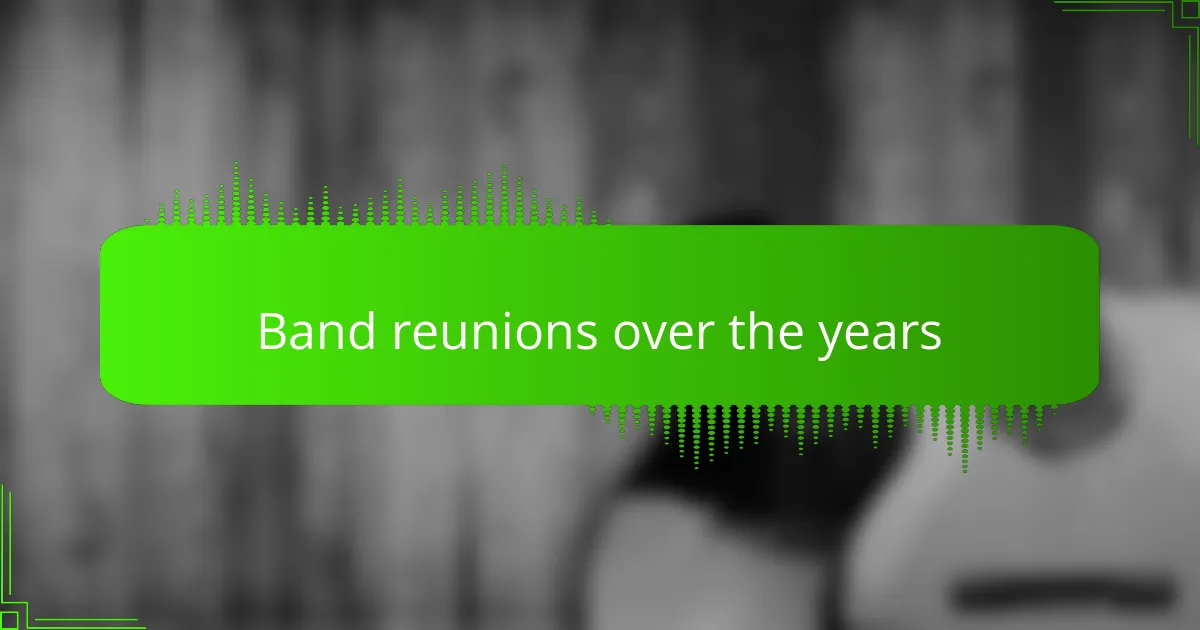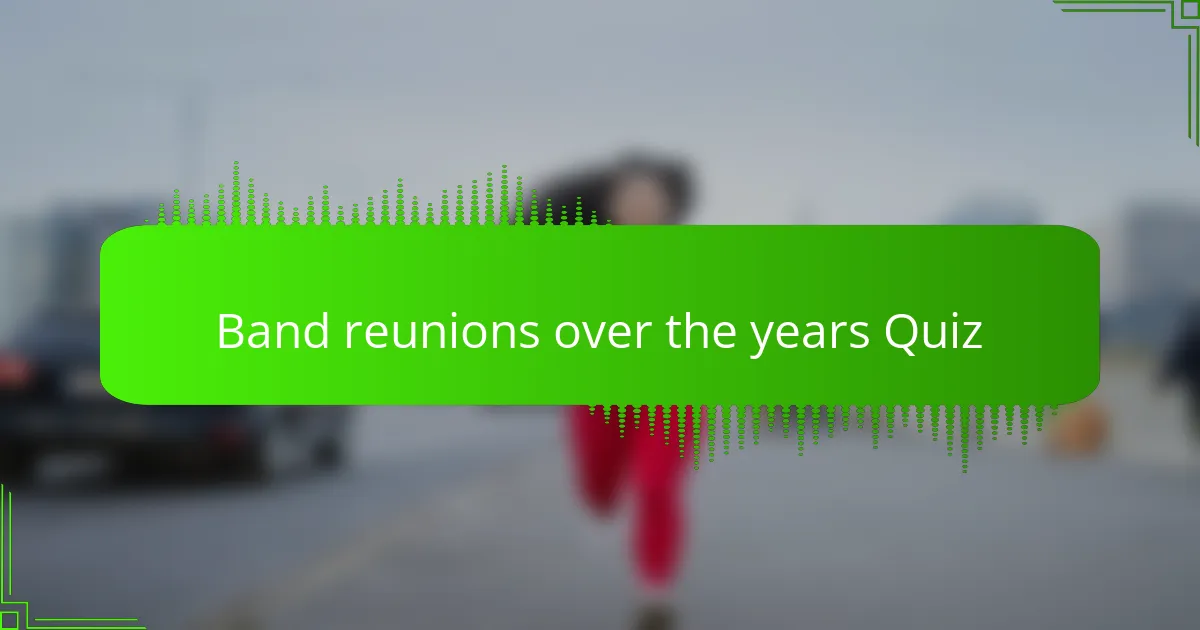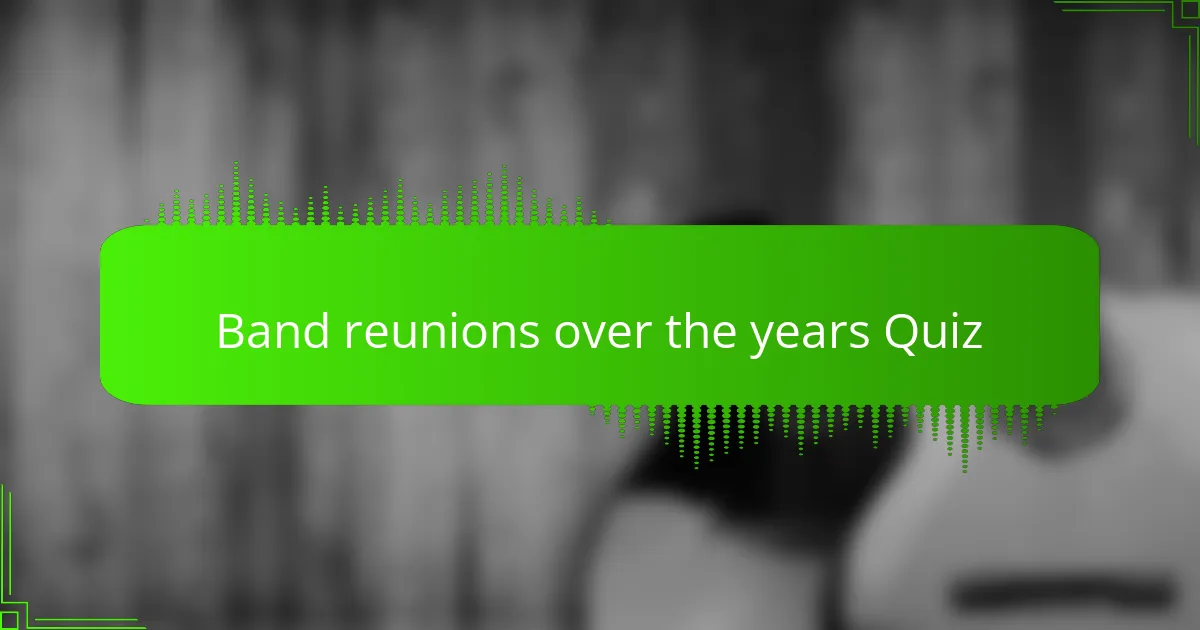
Quiz Completed: Celebrate Your Music Knowledge!
Congratulations on completing our quiz about band reunions over the years! You’ve tested your knowledge and uncovered fascinating details about some of the most iconic reunions in music history. From the reasons behind these comebacks to the emotional impact on fans, it’s clear that music brings people together in unique ways.
Throughout this quiz, you likely learned about significant milestones in the world of music. Each band reunion tells a story of camaraderie and nostalgia, reflecting the bond that artists share with their fans. It’s amazing to see how some bands managed to reignite their magic after years apart, delivering unforgettable performances and new music that resonates with listeners across generations.
We invite you to further explore our next section on band reunions over the years. Delve deeper into the stories behind these moments and discover how they have shaped the music landscape. Whether you’re a die-hard fan or just curious, there’s something for everyone to gain from this exploration. Happy reading!

Band reunions over the years
The Evolution of Band Reunions in Music History
Band reunions have transformed the music landscape since the 1970s. Initially, reunions were rare, often regarded with skepticism. However, iconic groups like The Eagles and Fleetwood Mac have set precedents, showing that successful reunions can reignite old fans’ passion and attract new audiences. This shift culminated in a period where nostalgia-driven tours became mainstream, with bands reuniting to capitalize on their legacy.
Notable Band Reunions in the 21st Century
The 21st century has witnessed several significant reunions, reshaping music culture. A prominent example is the reunion of Blink-182 in 2009, following years apart. Similarly, the return of Guns N’ Roses in 2016 for their “Not in This Lifetime” tour brought together Axl Rose, Slash, and Duff McKagan, generating considerable hype and financial success. Such reunions highlight the enduring appeal of classic lineups.
The Impact of Technology on Band Reunions
Technology has played a crucial role in facilitating band reunions. Social media platforms enable artists to communicate directly with fans. The online buzz surrounding the Pixies’ reunion in 2004 exemplifies this trend, where anticipation built rapidly via digital channels. Additionally, streaming platforms like Spotify and Apple Music allow fans to access catalogs easily, making reunions more relevant and marketing them more efficient.
Cultural Phenomenon: The Return of Legendary Bands
Reunions of legendary bands often serve as cultural milestones. The 2012 reunion of the original Black Sabbath lineup symbolizes this phenomenon. Their album “13” marked a significant return, blending nostalgia with contemporary rock sounds. Fans saw this reunion not just as a concert series but as a revival of an influential era in heavy metal, highlighting the band’s lasting impact on the genre.
Challenges and Controversies Surrounding Band Reunions
Reunions often come with challenges and controversies, affecting public perception. The departure of members before the 2015 reunion of The Smashing Pumpkins spurred debates on authenticity. Fans grappled with the question: is a reunion still valid without the original lineup? These challenges reflect wider discussions on legacy, artistic integrity, and the motivations behind band reunions in the music industry.
What are some notable band reunions that have occurred over the years?
Notable band reunions include the Eagles reuniting in 1994 after a 14-year hiatus, leading to the successful ‘Hell Freezes Over’ album. Another significant reunion was that of Fleetwood Mac in 2018, reuniting the classic lineup for a worldwide tour. Additionally, the Spice Girls returned as a group in 2019 for a tour without member Victoria Beckham. Each of these reunions resulted in increased ticket sales and renewed fan interest, showcasing the enduring impact of these bands.
How do band reunions impact the music industry?
Band reunions often lead to significant financial success through touring and new album releases. For instance, the 2007 reunion of Genesis grossed over $100 million from their world tour. Such reunions also revitalize interest in back catalog music, generating sales spikes for older albums. Moreover, they can create a cultural resurgence, attracting both old and new fans, thereby boosting the overall market for live music events.
Where do most band reunions take place?
Most band reunions take place in major urban centers known for hosting large concerts, such as Los Angeles, New York City, and London. Festivals also serve as venues for reunions, with events like Coachella featuring reunions of iconic bands, like the 2012 reunion of the Black Keys. Additionally, arenas and stadiums are common choices, as they can accommodate large audiences seeking to witness these significant musical events.
When did the trend of band reunions start gaining popularity?
The trend of band reunions began to gain popularity in the mid-1990s. This was notably marked by the Eagles’ reunion in 1994 and the subsequent success of the documentary ‘The Last Waltz,’ which reinvigorated interest in classic rock bands. By the early 2000s, many iconic bands began to reform, driven by both nostalgia and the lucrative potential of reunion tours, which continue to be prevalent today.
Who are some of the key figures behind famous band reunions?
Key figures behind famous band reunions often include band members themselves, management teams, and promoters. For example, Roger Waters’ involvement in the Pink Floyd reunion at Live 8 in 2005 was crucial for its realization. Additionally, managers like Irving Azoff have played significant roles in orchestrating reunions for bands like the Eagles. Their efforts often align with strategic marketing to maximize audience engagement and ticket sales.

